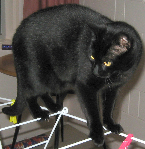countersinking problem
21 posts
• Page 1 of 2 • 1, 2
countersinking problem
hi,
I have a minor countersinking problem. I'm using a proper ali counter sink drill bit, in 3mm ali.
http://i135.photobucket.com/albums/q135/muggnz/rusty/countersinkingburrs.jpg
I cannot get the edge of the hole as smooth as I'd like by drilling. No matter how slow I drill, using light pressure & a slow speed drill. There always seems to be some rough edges.
The slowest speed of my drill press is 625 rpm.
I know I can sand them off, however that leaves other marks I'd rather avoid.
Is there an easy way of counter sinking, without creating this problem?
thanks
david
I have a minor countersinking problem. I'm using a proper ali counter sink drill bit, in 3mm ali.
http://i135.photobucket.com/albums/q135/muggnz/rusty/countersinkingburrs.jpg
I cannot get the edge of the hole as smooth as I'd like by drilling. No matter how slow I drill, using light pressure & a slow speed drill. There always seems to be some rough edges.
The slowest speed of my drill press is 625 rpm.
I know I can sand them off, however that leaves other marks I'd rather avoid.
Is there an easy way of counter sinking, without creating this problem?
thanks
david
-

Muggnz - Crybaby
- Posts: 600
- Images: 34
- Joined: Sat Apr 28, 2007 5:12 am
- Location: Karori, Wellington New Zealand
you are galling the material with the chips and the buildup on the CS. use some lube (wax, oil, soap, WD40 etc.) on both the material and the CS. don't keep the bit cutting continuously. drill a little and extract the bit a to clear the chips and repeat. keep the cutting edges of the CS clean AND SHARP and don't use a lot of pressure, just enough to make it cut and no more. slow rotation is correct.
that little lip on the surface tells me your bit is getting dull (or never was sharp to begin with) and/or you're cranking on the handle too hard.. since you say you're using light pressure and drilling with slow rotation my bet is your bit is dull (cheap hardware store countersink?)
that little lip on the surface tells me your bit is getting dull (or never was sharp to begin with) and/or you're cranking on the handle too hard.. since you say you're using light pressure and drilling with slow rotation my bet is your bit is dull (cheap hardware store countersink?)
Last edited by afreegreek on Tue Feb 02, 2010 5:21 am, edited 1 time in total.
- afreegreek
- 500 Club
- Posts: 723
- Images: 0
- Joined: Mon Jan 25, 2010 8:35 pm

 I know what it's like to get results you're not happy with..
I know what it's like to get results you're not happy with.. 